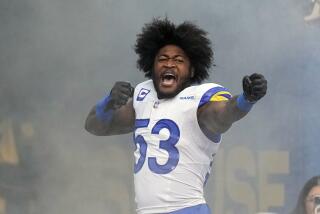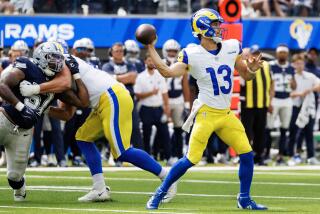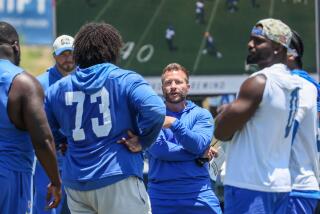WEIGHING THE DICKERSON TRADE : Some Components Are Missing, but Developing Picture Indicates Rams, Colts and Bills Benefited
One team’s fairy-tale ending to a famous football trade. The scene: Super Bowl XXIX, 1995. “Thank you, Commissioner Trump, thank you,” Eric Dickerson says in the Indianapolis Colts’ locker room as he hoists the Lombardi Trophy over his head. “I thought the first Super Bowl was sweet, but four is a nice round number.” (Cheers, cameras flash, applause.) “What was the question? Who? John Robinson? Yeah, I hear he’s selling commercial real estate with Steve Dils in Atlanta.” (Laughter.) “Let him run 47-gap with a Thomas Guide!” (More laughter.) “Boy, this trophy’s heavier than Greg Bell.” (More laughter.) Dickerson steps down from the podium.)
Another team’s version:
“Georgia,” says tailback Gaston Green, the Humphrey Bogart movie buff, “this could be the beginning of a beautiful friendship.” (Cleveland Gary and Greg Bell, part of the famed Triangle Backfield, join Green on the rostrum and douse each other in champagne.) “And we’d be remiss not to thank Senator Robinson,” Bell interrupts, “for leading us to our first three titles. . . . Why the goggles? Oh, it’s just my way of paying tribute to the man who got me out of Buffalo. What’s Dickerson up to these days, anyway? Someone said they saw him on People’s Court.”
The experts say it will take years to evaluate the Eric Dickerson trade. We can’t wait, especially with all the pieces finally in place and the Indianapolis Colts coming to Anaheim Stadium Sunday.
The $682,000 question (Eric’s 1987 Rams salary) remains: Was one football player, great as he is, worth seven players in return? And we’re not talking seven shirts right off the rack here, either. We’re talking four firsts and three second-round draft choices.
The three-team trade on Halloween 1987 was so complex it was only completed last April, when the Rams cashed their final picks on first-round fullback Cleveland Gary, second-round linebacker Frank Stams and cornerback Darryl Henley.
Dickerson, remember, was shipped to Indianapolis after a bitter contract dispute had turned ugly and personal. Yet it would take a steady finger to pull the trigger on this trade.
On Friday, Oct. 30, Colts General Manager Jimmy Irsay walked into Ron Meyer’s office and asked the head coach if he would like to make a run at Dickerson. Meyer, who coached the star at Southern Methodist University, almost fell off his chair.
The Colts, however, needed more ammunition to entice the Rams. So they shopped their unsigned first-round pick, linebacker Cornelius Bennett, to the Buffalo Bills for two first-round picks, a second rounder and tailback Greg Bell.
Now, the Colts were in business. For Dickerson, they could offer three first round picks, three seconds, Bell and one of their own backs, Owen Gill. Throwing in the players was one team’s way of saying “Keep the change.”
Late that Friday afternoon, history was made in time for Dickerson to catch a red-eye to Indianapolis. Nearly two years later, only one player, Gill, no longer figures in the equation. He’s out of football.
But we need winners and losers. Who got the best in this deal? Who got the worst?
So far, this much is known: Each of the three teams, all struggling before the trade, has made the playoffs since, although Dickerson’s Colts were edged out last season.
The consensus among analysts and league personnel experts interviewed is that all three teams improved themselves by the trade, although the Rams might be the long-term winner. Bennett gives the Bills a menacing presence on defense for years to come; Dickerson remains the best back in football; the Rams have re-stocked their team with top personnel.
Still, an evaluation isn’t that simple.
“A trade in football is a lot different than baseball or basketball,” Dick Steinberg, director of Player Development for the New England Patriots, said. “You have exact stats in those sports. You don’t have stats for linemen. It’s hard to put an exact value on players. You can’t tell if one guy is worth all this. With Dickerson and Indianapolis, they scare the hell out of us. We have to play them twice and they can win on any Sunday just because of him. But you’d have to say this is one deal that worked out well for everyone.”
Rams fans who opposed the trade dreamed of a backfield that included quarterback Jim Everett and Dickerson.
Joel Buchsbaum, a writer who scours the nation’s football talent for Pro Football Weekly, wonders if a Dickerson-Everett backfield would have been so great.
“Everett’s role would be reduced,” he said. “His development wouldn’t have been as rapid. And the Rams would be an older team now. And, if you’ve got Eric Dickerson, you’ve got to run the Eric Dickerson offense.”
Buchsbaum said the philosophies of the teams involved in the trade are clear: The Rams traded the present for the chance to become the team of the 1990s; the Colts went for the quick-fix with Dickerson, whose prime-time years are winding down at age 29.
“If they don’t knock on the Super Bowl door soon, it might not end up looking so good,” Buchsbaum said of the Colts. “They’ve mortgaged everything to win now.”
Those who had witnessed Ram drafts of the past lined up to see how they might mess up back-to-back opportunities that offered 10 of the top 112 college prospects in the nation.
Any more Mike Schads or Donald Evanses out there for the taking?
Yet our experts could find few faults with the six players chosen with the Dickerson draft picks.
“They’ve gone through some years in the ‘80s where their drafts haven’t worked out,” Steinberg said. “But these two drafts, no one can question them. . . . I don’t see how they can miss. If you analyze the good teams now, they were teams that had some multiple high picks. That’s how you dramatically improve. The rest of us are taking one guy in each round, and if one of them gets hurt . . .”
Now, a look at the principals in the deal, with assorted notes and comments.
ERIC DICKERSON
Dickerson speaks his mind and runs perhaps like no running back before him. It has taken him six years in the league to become the seventh all-time leading rusher in NFL history; he reached 10,000 yards (he now has 10,021) more quickly than anyone. When Charles White beat him out for the rushing title in the strike year, 1987, Dickerson said it was a fluke, and reclaimed the title for the fourth time last season with 1,659 yards.
Dickerson needs to average 1,135 yards a season for six years to pass Walter Payton and become the league’s all-time leading rusher.
The Rams had Dickerson and let him go. But at what price?
GREG BELL
He was the throw-in to the deal, but proved to be much more than that. A first-round draft choice with Buffalo in 1984, Bell drifted in and out of favor before being shipped to the West Coast. For one year, 1988, Bell made the Rams look like geniuses, finishing as the NFL’s fourth-leading rusher with 1,212 yards. The big question: Is he good for another such season?
“You’ll get the one big year out of him,” one NFL personnel director said. “Greg’s famous for that, one big year and going in the tank. But even for the one big year, they got their money’s worth. He’s got a history of inconsistency, but certainly as a throw-in, he was great.”
But for all the bad-boy stories that followed Bell west, Buchsbaum remains impressed.
“He had a terrific year for them last year,” Buchsbaum said, “if you exclude the month he was off. You know, people hate him, call him a bastard and a wimp, yet I see this guy run very, very well against very tough defenses.”
GASTON GREEN
He was the 14th overall pick in the 1988 draft and the Rams’ first choice via Dickerson. The former UCLA star was a bust as a rookie, being pushed out of the tailback rotation by Bell and Charles White. Green had a big game in Tokyo (116 yards on 28 carries) to start the summer, but has since been nicked with minor injuries.
The Rams, of course, passed on John Stephens to take Green, and are still waiting for the payoff.
Said one NFL personnel director: “There’s the injury factor. One thing you can’t control is injuries. He’s a talented back, but they haven’t got a lot of use out of him. School’s out on him. He ran great the first preseason game. If he stays healthy, he’s worth spending the choice.”
Consensus on the pick: Dangerous but not there yet.
AARON COX
The 20th player taken overall in 1988, Cox stepped right into the starting lineup and caught 28 passes for 590 yards and five touchdown as a rookie.
“I think he’s got a chance to be one of the better receivers in the league,” Buchsbaum said. “I was disappointed by the number of balls he dropped last year. He never dropped passes in college. But he does have fine hands and 4.4 speed.”
Cox has been slowed by a hamstring injury and seemed in jeopardy of losing his starting spot to Flipper Anderson. But most everyone agrees that Cox was the right choice.
Consensus on the pick: Solid.
FRED STRICKLAND
He was the third of three second-round picks in 1988 and by the end of his rookie season was an emerging star. The Rams moved him all over the field last year but will anchor him at a starting inside linebacker position.
Steinberg: “He’s playing better than a lot of people thought. Everyone knew he was tough, but there were questions about his instincts and reactions. He’s answered those questions. He’s around the ball. I think they got more than their value on him.”
Consensus on the pick: Better than most thought. Potential star.
CLEVELAND GARY
Some wondered why the Rams drafted another running back with the 26th pick in the draft. But the former University of Miami star is considered one of the best big receiving backs to emerge in years. Because of his holdout, however, he might not be able to contribute much this season.
Gary still thinks he should have gone higher in the round, and many agree.
“A lot of strange things happen on draft day,” Steinberg said. “Maybe teams felt they could get a back later, or were going for defensive players. Why didn’t (Andre) Rison go higher? There probably is a reason, but he (Gary) could have been a mid first-round pick.”
Consensus on the pick: Wait and see.
FRANK STAMS
The former Notre Dame linebacker and second-round pick this year has been moved inside to compensate for injuries and lack of depth. Stams is big, strong and can hit--ask Rodney Peete about it.
Steinberg: “He’s a tough competitive guy who could end up playing for a lot of years.
Buchsbaum: “He fits into their bastard (five-linebacker) defense. He’s half defensive end, half linebacker. He may be the future Kevin Greene. He’s a playmaker.”
Consensus on the pick: Solid.
DARRY HENLEY
The final compensation for Dickerson, and the third of three second-round Ram choices in 1989. Henley is a smallish cornerback at 5-feet-9 and 165 pounds, but he’s also going to be the new punt returner. Henley was impressive in summer camp, although some aren’t convinced he was a second rounder.
“He’s small,” one personnel director said. “He’s got to be a hell- of-a-cover guy. If he can be a consistent cover guy, he was worth it. I don’t think many teams would have taken him that high.”
Buchsbaum: “He may have been a reach where they took him.”
Consensus on the pick: The jury’s still out.
More to Read
Go beyond the scoreboard
Get the latest on L.A.'s teams in the daily Sports Report newsletter.
You may occasionally receive promotional content from the Los Angeles Times.











